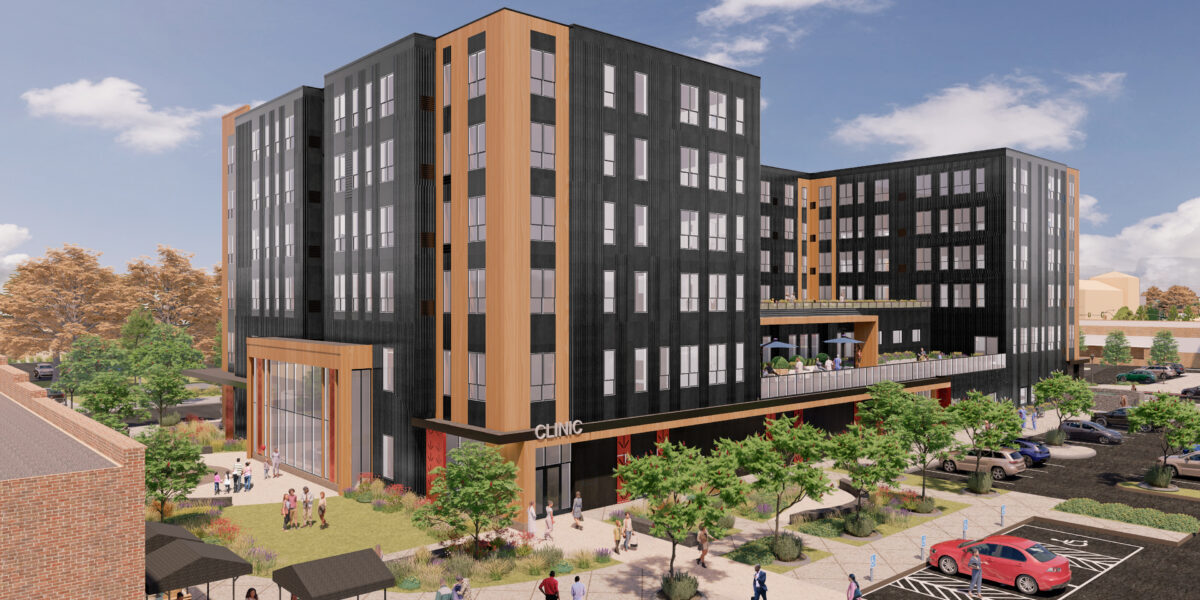
Image courtesy of Owámniyomni Okhódayapi.
This week, we’ll hear from the newly appointed Dakota-led design team supporting the restoration of Owámniyomni, also known as St. Anthony Falls. The team has plans to transform the Minneapolis site into a space that centers the land and its Indigenous history. Reporter CJ Younger has more on the story.
CJ Younger: June marked an exciting new development for the Dakota-led non-profit Owámniyomni Okhódayapi, formerly known as Friends of the Falls. After years of hearing from Indigenous community members and envisioning the restoration of the five acres of land at Owámniyomni, or St. Anthony Falls, the non-profit announced their design consultant: Seattle-based landscape architecture firm GGN. The firm will support a group of Dakota Knowledge Keepers representing multiple Dakota Tribes and communities to center Dakota culture at the site.
Barry Hand, program director of Owámniyomni Okhódayapi is Oglala Sioux, and was present for GGN’s proposal.

addressing the planning team on-site.
Image courtesy of Owámniyomni Okhódayapi.
Barry Hand: What was striking was the way the presentation went. There was no more gimmicks or technology. They have one of our respected elders and language treasures on their team and they brought everything back to a circle and honestly, it was a braid of sweet grass.
Younger: David Malda, principal GGN architect on the Owamniyomni project, is not Indigenous to Minnesota. But he and his design team are mindful of the learning they have left to do as they work with the Dakota Knowledge Keepers to understand the land’s history and significance to the Dakota people.
David Malda: How did the water move? What life did it support? What kind of experience and understanding of the land did this place support? How did people connect to one another here? We know that there’s a deep history of that here. And the people who have connections and deep, deep history that can’t be untied from this place, they get to be themselves here. And all the life that this place supports gets to be healthy and in its truth. And when we framework and design in that way…that’s restoring.
Younger: One of the Knowledge Keepers leading the design team is Cole Red Horse Taylor. Taylor is Mdewakanton Dakota and a member of the Prairie Island Indian Community. He’s an artist whose work is influenced by the history of the Dakota people, and what was and continues to be done to them and their sacred spaces.
Cole Red Horse Taylor: Dakota knowledge keepers are part of this project to give voice to us, the Dakota people, and acknowledge that we have different varying opinions about things. And so while I may not be a historian by background or anything like that, being an artist, a lot of times you do have to be a historian, too.
Younger: And the history of Owamniyomni is central to its restoration. The site, named for its turbulent waters, is sacred to the Dakota people. However, when white settlers colonized the land and displaced its Indigenous people, industrialists saw the Falls as a resource and exploited it for its hydropower. Today, it is a third of its former size.
Guided by the Knowledge Keepers, Malda and his team at GGN will begin considering ways to respect and honor the Falls and its history through its restoration.
Malda: If we don’t take the time to see what’s there—the stuff that’s been covered up, the stuff that’s been pushed aside, the stuff that’s been attempted to be erased—if we don’t take the time to find that true, that base, how can we ever hope that the thing that comes next is respecting it and honoring it, and in this case, restoring it?
Younger: Owámniyomni Okhódayapi hopes to begin the next chapter of the Falls by restoring a small part of the sacred site as a place open to all Indigenous people. Here’s Owámniyomni Okhódayapi program director Barry Hand.
Hand: If I walk down on the site and the choke cherries are ripe—those aren’t Dakota choke cherries, right? Those are just choke cherries. We want folks to come there as a two-legged relative and stand in solidarity with the restoration of the site because it’s not just restoring the site. It’s restoring a little bit of that humanity.
Younger: The design is expected to be completed in 2025, with construction planned for 2027. To learn more about the restoration, visit owamniyomni.org.
For Minnesota Native News, I’m CJ Younger.
More from Minnesota Native News
- New Native Theatre’s 15th Year & REAL ID
 This week, how REAL ID requirements impact Indigenous people, especially Two-Spirit individuals. Also, New Native Theatre’s latest play runs April 16-May 4.
This week, how REAL ID requirements impact Indigenous people, especially Two-Spirit individuals. Also, New Native Theatre’s latest play runs April 16-May 4. - Ziigwan Biidaajimowin (Spring News): NACC Issues Call for Artists and Little Earth Kicks Off American Indian Month with a Parade
 This week, Minneapolis’s Native American Community Clinic (NACC) seeks artists to commission pieces for their new building. Plus, nearby, the Little Earth of United Tribes housing community will kick off May’s American Indian Month with a celebration organized in part by the Minneapolis Public Schools American Indian Youth Council, Ogichida Oyate
This week, Minneapolis’s Native American Community Clinic (NACC) seeks artists to commission pieces for their new building. Plus, nearby, the Little Earth of United Tribes housing community will kick off May’s American Indian Month with a celebration organized in part by the Minneapolis Public Schools American Indian Youth Council, Ogichida Oyate - Indian Child Welfare Law Challenged at MN Supreme Court and Native Nations Impacted by Proposed SAVE Act
 This week, the Minnesota Supreme Court heard arguments in a case that could reshape child custody laws for Native American children. Also, the Safeguard American Voter Eligibility (SAVE) Act would require all Americans to prove their citizenship in person with official documents when registering to vote.
This week, the Minnesota Supreme Court heard arguments in a case that could reshape child custody laws for Native American children. Also, the Safeguard American Voter Eligibility (SAVE) Act would require all Americans to prove their citizenship in person with official documents when registering to vote.
Subscribe to Minnesota Native News in your favorite podcast app

 Upcoming Two-Spirit Powwow Celebrates Indigenous Culture and Identity
Upcoming Two-Spirit Powwow Celebrates Indigenous Culture and Identity